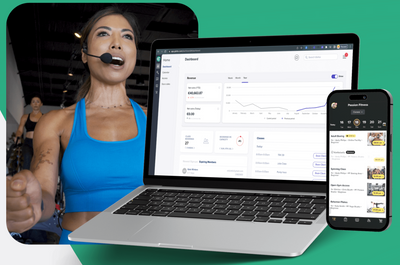
Below, we outline the essential steps aspiring gym owners should take to get their business up and running.
Why Open a Gym?
Outside of sharing your passion for fitness with others, there are some serious financial benefits to opening your own gym. While the average personal trainer makes around $67,000 annually, the average gym owner brings in over $131,000. That's a significant salary increase for those already working in the fitness industry.
On top of the bump in income, the United States fitness industry is expected to grow 171.75% between now and 2028, indicating a promising market outlook.
Types of Gyms
From yoga studios to functional fitness centers, there’s a seemingly endless list of gym styles to choose from. This can make it challenging to know which type of business you should open. Understanding a few common gym business models can help you determine which style aligns most with your goals.
Get our fitness newsletter
Stay on track with your fitness goals and get inspired! Sign up for the GymBird newsletter for twice-monthly expert fitness and nutrition tips.
Conventional Gyms
Conventional gyms appeal to a broad clientele because they offer a little of everything. At these gyms, you’ll find cardio machines, free weights, lifting equipment, and group classes. Many also offer amenities like pools, childcare, and saunas to attract more members.
Boutique Gyms
Boutique gyms are smaller businesses that provide their members with a more intimate atmosphere than commercial gyms. These studios typically specialize in one exercise style, like yoga, cycling, or pilates.
Personal Training Gyms
Personal training gyms are smaller facilities that provide members with one-on-one attention. These gyms create customized programs for each member, ensuring they have a bespoke experience.
Franchise Gyms
A gym franchise is a business where the owner, known as the franchisor, allows others, called franchisees, to use their business model, company name, and trademarks. You typically pay an initial fee to join the franchise and then ongoing fees based on a percentage of your revenue. This business style can include both traditional gyms and boutique fitness studios.
Legal Requirements for Opening a Gym
Before starting a gym, make sure you meet all the necessary legal requirements to operate in compliance with local laws and to safeguard both yourself and your customers.
Registering Your Business
Registering your gym establishes it as a legal entity. Proper registration demonstrates your commitment to operating a legitimate business that abides by local laws and regulations. This not only helps build credibility with both customers and investors but also ensures you have the legal framework to protect your personal assets in case your business faces liabilities or financial challenges.
Obtaining Necessary Permits and Licenses
Nearly every small business needs licensing and permits to operate legally. These requirements vary based on location, so it’s essential to check with your city and state to ensure you have the correct permits.
The following licenses are commonly required when opening a gym:
- Business License
- Zoning and Building Permits
- Sales Tax Permit or Business Number
- Federal Employer Identification Number
- Certificate of Occupancy
- Professional Licensing
- Music Licensing
Your city may require additional permits if you offer amenities like childcare or food and beverages.
Insurance Requirements
No matter how diligent you are, sometimes unforeseen circumstances happen. When accidents occur at your gym or property gets damaged, insurance provides a safety net, covering the cost in certain situations. This protects your gym’s financial health.
Gym insurance consists of a combination of policies designed to safeguard your business. While specific needs may vary, the following list commonly comprises insurance coverage for fitness facilities:
- General Liability
- Professional Liability
- Worker’s Compensation Insurance
- Commercial Property Insurance
- Medical Payments Coverage
- Business Interruption Insurance
- Business Equipment Insurance
Marketing Strategies for a New Gym
You can have the best trainers and the highest quality facilities, but if no one knows your business exists, you won’t succeed. A strategic marketing plan helps build brand awareness, ensuring the right people hear about your gym.
Identify Your Target Audience
Before starting any marketing initiatives, you need to understand your target audience. These are the consumers most likely to want your services.
To help identify this key group of people, consider what makes your gym stand out from your competition. Maybe you offer a variety of equipment and an affordable price point, appealing to consumers interested in a cost-effective way to exercise. Or, perhaps you own a boutique yoga studio, attracting members interested in gentle movement and a tight-knit community.
Understanding your gym’s unique selling points and who would benefit most from these features can help you establish your target audience.
Creating a Strong Brand Identity
Now that you’ve identified your target audience, you need to prove to them that your gym is the perfect fit. How do you do that? Through building a strong brand identity.
Your gym’s brand identity includes all the visual elements of your brand, like your name, logo, colors, and images used in your advertising. Research shows that presenting a consistent brand identity can increase a company’s revenue by up to 33%, so it’s essential not to skip this step in your marketing.
Many gym owners work with a graphic designer to create their brand’s image. But, if this option falls outside your budget, tools like Canva can help you create a brand identity at an affordable price point.
Building a Website
Most people conduct online research before making a purchasing decision. Having a website allows your target audience to discover you online. This not only serves as a tool to educate prospects about your gym, but it can also boost sales by allowing visitors to purchase memberships and book classes.
Hiring a website designer can help simplify the website creation process. But if you’re searching for a more budget-friendly option, website-building software like Squarespace or Exercise.com provide an affordable alternative.
Utilizing Social Media
Your target audience likely spends a significant amount of time scrolling Instagram or commenting on Facebook. In fact, research shows that the average person spends 145 minutes on social media every day. Creating social media campaigns on platforms your target audience regularly uses helps build brand awareness and engages prospective members.
Building Email Marketing Campaigns
99% of consumers check their email daily, making it a powerful tool in your advertising arsenal. Gym owners can use email marketing for a variety of initiatives, including promotions, developing relationships with new customers, and engaging sales leads.
Using Print Advertising
In a digital world full of TikTok dances and Instagram reals, print advertising may seem archaic. However, this old-school marketing tool can help you stand out from your competition.
It’s estimated that consumers see up to 10,000 advertisements daily. Print advertising in the form of direct mail, brochures, and flyers helps your gym cut through the digital noise and make a lasting impact on your target audience. In one study, 75% of participants remembered brand names from print mail ads, but only 44% remembered brand names from digital ads.
Local Partnerships
Partnership marketing involves two or more businesses collaborating on a marketing campaign to achieve shared business goals. For gyms, this could mean organizing joint fitness events or partnering with nutrition companies to provide members with exclusive supplement deals.
By utilizing this marketing tool, gyms can expand their exposure to new audiences, boost brand awareness, and unlock sales opportunities within previously untapped target groups.
Retaining Members for Your Gym
It's tempting to constantly keep your eyes peeled for strategies to attract new customers. However, retaining the members you have is equally as important. Experts agree that the cost of acquiring a new customer is significantly higher than keeping an existing one. Use the following strategies to ensure your gym members stick around for the long haul.
Provide an Exceptional Customer Experience
Three out of five consumers report that quality customer service is essential for building brand loyalty. This loyalty is especially important for businesses like gyms, which rely on recurring memberships to stay open.
Luckily, providing your patrons with a top-notch customer experience can be simple. Learning member names, greeting them before workouts, and training staff on customer service best practices can all help ensure your members feel valued.
Creating an Inclusive Atmosphere
For many people, exercising at a gym is an anxiety-evoking experience. According to a recent survey, 2 in 5 adults avoid going to the gym because they are self-conscious. Improve your members' confidence and reduce gym anxiety by creating an inclusive atmosphere.
An inclusive gym should feel welcoming to all races, genders, physical abilities, and ages. A few ways you can support inclusivity include educating trainers on modifications for a range of abilities and hiring employees from a variety of backgrounds.
Organizing Community Events
Helping members feel connected to their gym community provides a myriad of health benefits and makes them more likely to return. Humans thrive in community settings. A strong sense of belonging can boost happiness, reduce mental health challenges, and improve overall well-being.
Hosting community events like charity runs, group workouts, or post-workout happy hours creates opportunities for members to connect, make friends, and share their fitness experiences.
Cost of Opening a Gym
The cost of opening a gym varies based on many factors, including location, equipment, renovations, and staffing. Depending on the type of gym you want to open, startup costs can range from $50,000 to well over $1,000,000.
Below, we'll discuss the costs you should plan for when opening your gym.
Location and Facility Costs
Property costs are the largest upfront and ongoing expense. Prospective gym owners can buy or rent their gym facilities.
Buying a Gym
If you want to buy a gym, expect to pay between $200 to $300 per square foot. Gyms in highly desirable locations can sell for up to $500 or more per square foot.
Renting a Gym
Gyms typically rent for $20 to $30 per square foot per year. However, premium locations can cost $50 or more per square annually.
See also: How much does it cost to open a gym?
Equipment and Supplies
The cost of equipment and supplies will largely depend on the type of fitness facility you open. For example, if you open a yoga studio, you’ll likely only need yoga mats and props. This may cost as little as $1,000. However, if you’re opening a large commercial gym, plan on investing much more.
As a rule of thumb, most gyms can expect to pay around $25 per square foot on equipment.
Remodeling and Decor
New gyms provide owners with a blank canvas to create their ideal exercise environment. From installing showers and lockers to replacing flooring and building a reception area, gym remodels aren’t cheap. But they’re necessary to create a welcoming and safe environment for members.
Gym owners should budget $35 or more per square foot for remodels.
Staffing and Payroll
You’re likely not running a gym alone, so it’s important to consider the costs associated with hiring and compensating employees like gym managers, personal trainers, accountants, and marketing professionals.
These individuals will typically require payment either hourly or through an annual salary.
Potential Revenue Streams for Gyms
Passion alone won't keep your gym's doors open. At the end of the day, you need to make a profit for your business to thrive. Use the revenue streams below to add value for members and make more money.
Membership Fees
Monthly memberships are one of the most popular revenue streams for gyms. For a set cost, memberships grant gym-goers access to classes, equipment, and amenities. In 2021, the average gym membership cost $507 for the first year and $479 for the succeeding years since there were no additional initiation or enrollment fees.
Personal Training Services
Personal training provides your members with one-on-one attention for an additional cost. Most gyms charge clients $65 or more an hour for individual training, making this service a lucrative offering.
Group Fitness Classes
Offering workout classes helps build your gym’s community and provides another revenue stream. Depending on your business model, some classes may be included in your monthly membership fee. But, if you offer specialty classes, you can sell class punch cards or single-pass classes. Most boutique fitness classes cost around $34 per class.
Retail Sales
Make your gym a one-stop shop for your members’ wellness needs by offering additional products. Selling fitness apparel, supplements, and post-workout snacks can enhance their overall experience, making it convenient for them to access everything they need for a successful fitness journey at your facility.
The average gym makes an additional $2,600 per month from retail sales.
Bottom Line
Opening a gym can be a time-intensive venture. But, with a bit of grit and perseverance, fitness entrepreneurship provides a rewarding path to share your passion with others. If you're unsure where to start, check out the U.S. Small Business Administration's website. They offer many resources to help aspiring business owners get started.



